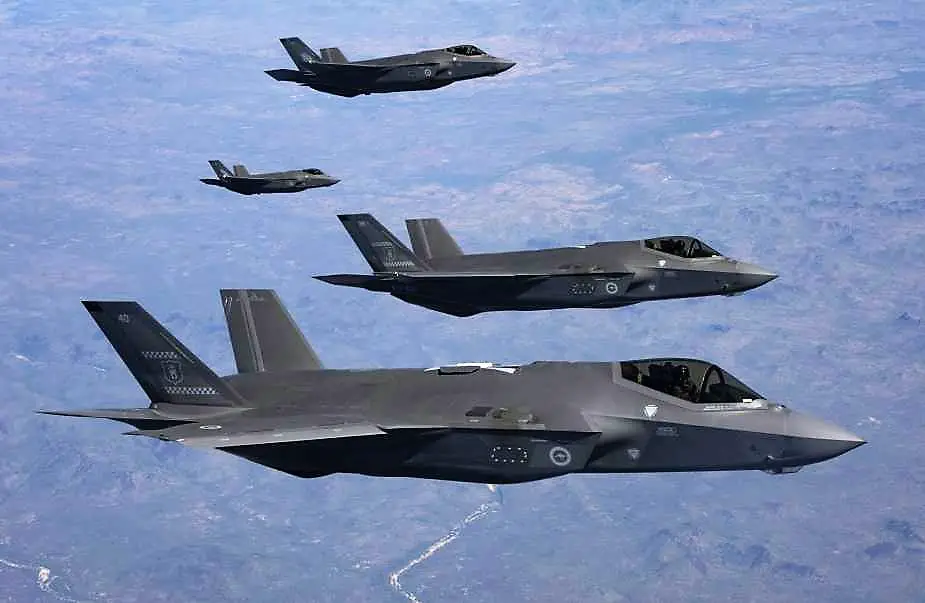Breaking news
US Air Force and Royal Australian Air Force conduct bilateral training during Talisman Sabre 23.
The U.S. Air Force and Royal Australian Air Force executed numerous high-end, multi-domain flying missions from bare bases across the Northern Territory and Western Australia during Talisman Sabre 2023, a biennial large-scale military exercise between Australia and the United States that started in 2005. This is the 10th and largest iteration of the exercise with more than 30,000 personnel from 13 countries participating. Capt. Margaret Kealy-Machella reports.
Follow Air Recognition on Google News at this link
 A Royal Australian Air Force E/A-18G Growler from No. 6 Squadron, RAAF Base Amberley, taxis to launch during Talisman Sabre 23, at RAAF Base Tindal, Northern Territory, Australia, July 22, 2023 (Picture source: U.S. Air Force/1st Lt. Robert H. Dabbs)
A Royal Australian Air Force E/A-18G Growler from No. 6 Squadron, RAAF Base Amberley, taxis to launch during Talisman Sabre 23, at RAAF Base Tindal, Northern Territory, Australia, July 22, 2023 (Picture source: U.S. Air Force/1st Lt. Robert H. Dabbs)
Talisman Sabre 23 provides both the RAAF and the U.S. Air Force with a unique challenge and exceptional opportunity: executing agile operations on a scale never seen in a bilateral exercise across an expansive geographical area “. From our perspective, it's much more complex this time. It brings its own challenges, having things spread out across the north and west,” said RAAF Air Commodore Pete Robinson, Air Task Group commander. “It's much more convenient to be at one place and have everything under your control there, but this is a good challenge.”
The combined air components departed RAAF Base Darwin and moved to RAAF Bases Curtin and Tindal, where the operations and support teams generated large force movements enabling agile operations in airspace across the north and west of Australia.
For the team across the three bases, the primary objective throughout the exercise is increasing interoperability in every aspect of operations, but during flying missions. These missions included the integration of RAAF and U.S. Air Force assets, but also U.S. Navy including aircraft from the aircraft carrier USS Ronald Reagan (CVN 76). “Being out here has given our warfighters an opportunity to mission plan, brief, execute and debrief with some of our key allies in the region, and the learning has been invaluable,” said U.S. Air Force Lt. Col. Paul Lopez, 199th Air Expeditionary Squadron commander. “The experiences the warfighters are gaining have been well above average, and the lessons we're learning during this exercise are lessons we're going to be able to apply in the future.”
Bringing together diverse aircraft capabilities to fly missions in the same airspace, while integrating as a collective team takes a lot of bilateral planning. This planning occurs at RAAF Base Darwin, but also with the forward units ensuring every detail is discussed and decided, as a team.
“Bilateral mission planning is important because it brings all of the players to one common space where they can discuss gameplans, capabilities, leadership styles, thought processes and levying experiences in order to ensure a thorough mission planning process and ultimately, mission success,” said U.S. Air Force Capt. Desmond Jackson, 19th Fighter Squadron Raptor Intelligence chief.
Once mission planning is finalized and briefs completed, the aircrews are ready to roll. Aircraft such as the U.S. Air Force F-22 Raptor and KC-46 Pegasus, alongside RAAF F-35A Lightning II, KC-30A Multi-role Tanker Transport, F/A-18F Super Hornet, E/A 18G Growler and P-8A Poseidon, take to the skies.
“These large force employment missions are huge for getting everybody on the same sheet of music, especially tactics-wise, and that will help us further advance our capabilities as an allied force,” said U.S. Air Force Capt. Christopher Loo, 199th Expeditionary Fighter Squadron F-22 pilot, Joint Base Pearl Harbor-Hickam, Hawaii. “We go out, fly, regroup, fly more, land, debrief, all with the Royal Australian Air Force.”
After the aerial training event is complete, maintainers from the U.S. Air Force and RAAF, inspect each aircraft and ensure mission readiness. Beyond ground maintenance, fuel is a critical factor to get the aircraft in the skies.
Refueling occurs on both the ground and mid-air. The U.S. Air Force KC-46 and the RAAF KC-30As are both able to refuel mid-air, further increasing the time and distance each aircraft fly. In addition, there is a ground crew fueling a variety of airframes side by side as a bilateral team.
“We’ve been learning how their equipment is different and how we could integrate with the RAAF to see how we can do things better,” said U.S. Air Force Staff Sgt. Corey Broder, 13th Air Expeditionary Wing fuels distribution operator, petroleum, oils, and lubricants flight. “Every challenge during this exercise helps, because when it’s the real thing, we know what to do, seamlessly rolling with it.”
Generating large sorties with many aircraft to accomplish bilateral training objectives is a normal day's work in executing Talisman Sabre in the Northern Territory and West Australia. The exercise continues to grow and become larger and more complex for the air component in future iterations.
“I've been the lead for the United States Air Force for Talisman Sabre since 2019. Just in that short amount of time, I’ve seen the relationship between the RAAF and USAF strengthen to the point where we know exactly who to call when faced with a challenge,” said Col. Brian Baldwin, 13th AEW commander. “We have friends that help us overcome those challenges more quickly, and I can’t wait to see how our combined team gets after new challenges in the next Talisman Sabre.”
 Royal Australian Air Force F-35A Lightning IIs, assigned to No. 3 Sqn (Picture source: U.S. Air Force/Tech. Sgt. Eric Summers Jr.)
Royal Australian Air Force F-35A Lightning IIs, assigned to No. 3 Sqn (Picture source: U.S. Air Force/Tech. Sgt. Eric Summers Jr.)



















